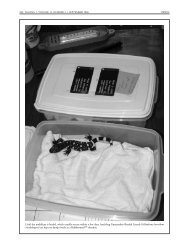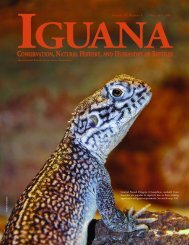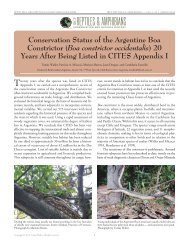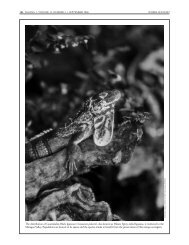Spiny-tailed Iguanas (Ctenosaura similis) in Venezuela
Spiny-tailed Iguanas (Ctenosaura similis) in Venezuela
Spiny-tailed Iguanas (Ctenosaura similis) in Venezuela
You also want an ePaper? Increase the reach of your titles
YUMPU automatically turns print PDFs into web optimized ePapers that Google loves.
ROBERT POWELL<br />
AMPHIBIANS AND REPTILES OF DOMINICA<br />
on St. Lucia and the Maria Islands. These small lizards (maximum<br />
SVL 48 mm) <strong>in</strong>habit dry leaf litter with relatively high<br />
amounts of sunlight along the leeward (western) coast, and are<br />
particularly abundant <strong>in</strong> Cabrits National Park. Ground color is<br />
golden with darker lateral bands and golden-yellow canthal<br />
stripes that cont<strong>in</strong>ue over the eyes and fade near the h<strong>in</strong>dlimbs.<br />
Worm Lizards often are thought to be juvenile sk<strong>in</strong>ks. Unlike<br />
some other species <strong>in</strong> the genus, G. pleii is bisexual. Lizards presumably<br />
feed on small arthropods. The species’ conservation status<br />
has not been assessed.<br />
Gymnophthalmus underwoodi (Grant 1958). Squamata:<br />
Gymnophthalmidae. No local name. English common name:<br />
Smooth-scaled Worm Lizard. Neotropical endemic, with populations<br />
on the South American ma<strong>in</strong>land and a number of Lesser<br />
Antillean islands; the population on Dom<strong>in</strong>ica presumably is<br />
native (established by natural means), but the <strong>in</strong>troduction may<br />
have been human-mediated. These small, diurnally active,<br />
ground-dwell<strong>in</strong>g lizards (maximum SVL 43 mm) are associated<br />
with leaf litter <strong>in</strong> dry forests, beachside vegetation, and mixed<br />
agriculture with <strong>in</strong>troduced orchard trees, usually at sites where<br />
sunlight penetrates for at least part of each day. Populations are<br />
known only from the leeward (western) side of the island from<br />
sea level to elevations of ~300 m. Body scales are smooth. The<br />
metallic brown back and silvery-white belly are separated by a<br />
dark brown lateral stripe. These lizards forage for small <strong>in</strong>vertebrates<br />
<strong>in</strong> the leaf litter. Predators <strong>in</strong>clude cats, wild birds and<br />
chickens, and presumably snakes and larger lizards. This species<br />
is entirely female, reproduc<strong>in</strong>g by means of parthenogenesis<br />
(eggs develop<strong>in</strong>g without fertilization), enhanc<strong>in</strong>g the species’<br />
ability to colonize new areas, as only one <strong>in</strong>dividual is necessary<br />
to found a population. Gymnophthalmus underwoodi and G. pleii<br />
appear to be allopatric (do not occur together). The conservation<br />
status of the species has not been assessed.<br />
Smooth-scaled Worm Lizards (Gymnophthalmus underwoodi) are all<br />
females, reproduc<strong>in</strong>g by means of parthenogenesis (eggs develop<strong>in</strong>g<br />
without fertilization), enhanc<strong>in</strong>g the species’ ability to colonize new<br />
areas, as only one <strong>in</strong>dividual is necessary to found a population.<br />
Iguana delicatissima (Laurenti 1768). Squamata: Iguanidae. Local<br />
name: Lèza. English common name: Lesser Antillean Iguana.<br />
Lesser Antillean endemic. These large lizards (male SVL to 434<br />
mm, female SVL to 401 mm) occur <strong>in</strong> natural and altered habitats<br />
along cliff faces, <strong>in</strong> lowland forests, and often close to streams.<br />
Although the distribution is largely coastal, iguanas may be found<br />
at elevations to ~300 m. Concentrations may occur <strong>in</strong> the vic<strong>in</strong>ity<br />
of communal nest<strong>in</strong>g beaches to which females migrate from<br />
considerable distances. These lizards are largely arboreal but reg-<br />
IGUANA • VOLUME 15, NUMBER 3 • SEPTEMBER 2008 137<br />
ularly venture onto the ground. Color varies greatly. Hatchl<strong>in</strong>gs<br />
are bright green, but this fades with age to dark gray with h<strong>in</strong>ts<br />
of green, blue, brown, and occasionally p<strong>in</strong>k around the snout<br />
and facial features. Males tend to be darker than females, which<br />
frequently reta<strong>in</strong> a primarily green coloration <strong>in</strong>to maturity.<br />
Males have larger heads, prom<strong>in</strong>ent dewlaps, and conspicuous<br />
femoral pores on the undersides of their thighs. Individuals spend<br />
much of their time adjust<strong>in</strong>g body positions and perch heights<br />
to regulate body temperatures. The diet <strong>in</strong>cludes flowers, fruits,<br />
and leaves of many plants. <strong>Iguanas</strong> are quick to exploit <strong>in</strong>troduced<br />
ornamentals and appear to have a particular fondness for<br />
hibiscus. Juveniles are known to eat bird eggs, and iguanas of all<br />
ages may scavenge. Adults have few predators except humans and<br />
the occasional boa, but major predators on eggs and hatchl<strong>in</strong>gs<br />
<strong>in</strong>clude crabs, rats, and Ameiva fuscata. The species is <strong>in</strong>cluded<br />
Lesser Antillean <strong>Iguanas</strong> (Iguana delicatissima) are phenomenally abundant<br />
on the grounds of the Sunset Bay Club on Dom<strong>in</strong>ica’s leeward<br />
(western) coast. The proximity of the Batali River and a communal nest<strong>in</strong>g<br />
site, an abundance of forage, and the tolerance of the resort’s owners<br />
account for population densities seen nowhere else <strong>in</strong> the world.<br />
Male Lesser Antillean <strong>Iguanas</strong> (Iguana delicatissima) are very territorial.<br />
The proximity of adult males on the ground of the Sunset Bay Club<br />
resulted <strong>in</strong> overlapp<strong>in</strong>g home ranges and frequent agonistic <strong>in</strong>teractions.<br />
JOHN S. PARMERLEE, JR.<br />
ROBERT POWELL








